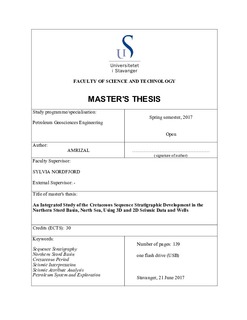| dc.description.abstract | The Cretaceous interval of the northern Stord Basin is under-studied stratigraphic successions due to its minor significance for the oil and gas industry. Therefore, the available subsurface data is limited, especially well and high-resolution seismic data. However, state-of-the-art 3D broadband seismic data were recently acquired in the western part of the northern Stord Basin, giving an opportunity to develop a temporal and spatial distribution of reservoir and seal pairs, source rocks, and traps.
Nine key seismic surfaces were mapped (Base Cretaceous Unconformity, Top Unit A1, Top Unit A2, Downlap Surface 1, Unconformity 1, Top Unit D, Downlap Surface 2, Unconformity 2, and Top Shetland Surface) within the post-rift Cretaceous strata of the northern Stord Basin, which divide this interval into seven main seismic units (Units A-G). Seismic stratigraphic interpretation confirms that the eustatic sea-level rose during the Cretaceous period. However, it was interrupted by two base-level falls during the Berriasian and in the Cenomanian times. Several highs controlled the deposition in the study area, such as the Oseberg and the Troll Fault Blocks, the Bjørgvin Arc, and the Øygarden Fault Complex. All structural highs, except the Øygarden Fault Complex, were flooded the latest in the Turonian time.
Two complete and an incomplete second-order cycle sequences bounded by unconformities were identified in the study area. These sequences comprise a falling-stage systems tract (FSST 1), three lowstand systems tracts (LST 1, 2, and 3), two transgressive systems tracts (TST1 and 2), and two highstand systems tracts (HST 1 and 2).
The Åsgard deep-marine basin-floor fans (Unit A1) and the Agat and Tryggvason formations prograding shallow marine sandstones (Unit C and F) are two clastic-rich geometries within the Cretaceous interval in the study area. In addition, the Tryggvason and Ekofisk formations slumping-related chalky limestones (Unit G) are possibly also a good reservoir rock. The Sola (Unit C) and the Blodøks (Unit E) shales are potential source rocks interval, where the Sola shales are predicted to be in the early mature oil window, while the Blodøks shales are still in the immature oil window. The potential seal rocks are the intervening Åsgard claystones (Unit A2), other intra-formational claystones, and ultimately by the overlying Cenozoic sediments. The primary traps within the Cretaceous are stratigraphic traps, such as pinch-out in Unit A1 and truncation in Unit C and F. The lack of well data in the study area leads to the uncertainty of source rock maturity. Therefore, the hydrocarbon charging is expected to be from the Viking Graben in the east, which often is seen to be risky due to long-distance migration. | nb_NO |
